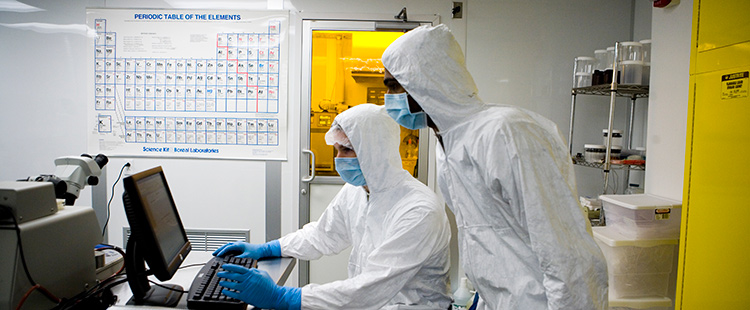Courses: EOP 533 / ECE 580
- Design of cleanrooms
- Contamination control
- Chemical safety
- Kinetic theory of gases
- Vacuum pumps and vacuum systems
- Pressure and flow measurements
- Fundamentals of gas plasmas for device fabrication
- DC, RF, parallel plate and magnetron, ICP configurations
- Thermal evaporation
- Sputter removal and deposition
- Pulsed laser deposition
- Co-deposition, compounds, alloys and reactive deposition
- Chemical vapor deposition
- Thin film measurement and control
- Thin film materials
- Optical thin film design and deposition
- Silicon crystal growth, crystallography and wafer manufacture
- Silica
- Sapphire
- III-V and II-VI compound semiconductors
- Substrate cleaning processes and preparation
- Spin coating
- Principles of substrate priming
- Photomask technology
- UV and EUV light sources
- Contact mask lithography
- Project mask lithography
- Direct write lithography
- Basic properties of photoresists, Dill parameters and numerical modeling
- Image reversal and negative tone photoresists
- SU-8 photoresist
- Patterning with etch-down, lift-off and linearization
- Laser interference lithography
- Resolution enhancement techniques (phase shifting, SADP, DSA)
- EUV lithography
- E-beam lithography
- Nanoimprint lithography
- Metal and dielectric etches
- Orientation dependent wet chemical etches on silicon (KOH, TMAH)
- Fundamentals of plasma etching
- Parallel plate and inductive plasma etching
- Silicon plasma etch chemistries (SF6, CF4, Cl2)
- Doping by thermal diffusion
- Doping by ion implantation
- Masking materials for doping
- Thermal oxidation of silicon
- Theory of making metal contacts to silicon
- FEOL and BEOL processes
- Thermal budget
- Foundry processes
- Substrate defect metrology
- Lithography metrology
- Gate dielectrics
- Metrology for ion implantation
- Interconnect metrology
EOP 532: Optical Thin Film Design
- Maxwell’s equations & plane wave propagation
- Waves across dielectric boundaries
- TE and TM waves
- Oxides
- Fluorides
- Nitrides
- Sulfides
- Semiconductors
- Metals
- Theory of complex effective reflectance index
- Single-film anti-reflection
- Quality factor
- Normalized frequency
- Mathematical derivation
- Incoherent backside reflection
- Film stacks on both sides of the substrate
- Materials with complex dispersive refractive indices
- Calculation of absorption in thin films
- TE and TM oblique incidence
- Two-layer quarter-wave design
- Two-layer non-quarter-wave design
- Principles of three-layer designs with absentee layers
- Double-V designs
- Designing anti-reflection for a substrate that already contains films
- Structured and gradient index films
- Periodic structures
- High-reflection designs with periodic symmetric unit cells
- Broadband reflectors
- Trilayer unit cell
- Effective reflectance index contour with repeating unit cells
- Bragg reflection and stop band
- Long pass and short pass filters
- Transition characteristics
- Numerical optimization
- Design examples
- Single cavity designs
- Resonant-cavity enhancement
- Vertical cavity surface emitting lasers (VCSEL)
- Coupled cavity designs
- Coupled cavity bandpass filters
- Single-layer and multi-layer antireflection designs for oblique incidence
- Effective reflectance index contours for oblique incidence
- Thin film polarizing beam splitter
- Optical properties of metals
- Antireflection designs for metal substrates
- Antireflection for semiconductor substrates
- Bandpass filters using metal films
- Metal-insulator-metal (MIM) cavity
- Coupled cavity metal-dielectric bandpass filters
- Antireflection designs using phase change materials
- Resonant cavity structures with phase change materials
- Vanadium Dioxide (VO2) phase change material
- Ge2Sb2Te5 (GST) phase change material
- Physical vapor deposition (PVD) methods
- Chemical vapor deposition (CVD) methods
- Thickness monitoring and control
- In-situ optical performance monitoring
- Thin film stress and control

